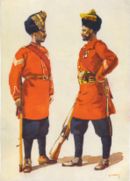Bengal Infantry Regiments
| Bengal Army | |
|---|---|

| |
| Bengal Army | |
| List of Bengal Army Regiments | |
| Bengal Infantry Regiments | |
| Bengal Infantry Finder tool | |
| Bengal Artillery | |
| Bengal Horse Artillery | |
| Bengal Sappers and Miners | |
| East India Company Army | |
Contents
Introduction
European Regiments
Three units were raised between 1652 and 1765 which became regiments of the British Army in 1861. Three further regiments were formed in 1858 with officers from Native Regiments which had mutinied but these were disbanded after the Indian Mutiny.
Indian Regiments
Beginnings
After the recapture of Calcutta in 1757, the Council of Madras ordered Robert Clive to raise fighting units of sepoys with officers from the Madras establishment. These units were called battalions, named after their commanding captains, and each comprised 42 Indian non-commissioned officers and 820 rank & file. They were originally numbered (as the British Army) with the 1st being the oldest and the highest number being the youngest. In 1764 the battalions were numbered according to the seniority of their captains and totalled 18 battalions. In 1765 the Bengal Army was divided into three brigades each with with one troop of cavalry, one company of artillery, one regiment of European infantry and seven battalions of native infantry.
Clavering Reform
In 1775 General John Clavering, commander-in-chief, gave the units in the three brigades sequential numbers which changed the number of every battalion except the 21st. In 1778 six battalions from the 1st Brigade were sent to Bombay for the 1st Maratha War and six new battalions raised to replace them. Six battalions which had been raised under British officers for the Vizier of Oude were brought into HEIC service.
Formation of Regiments
In 1781 every battalion was increased to 1,000 men and designated a regiment commanded by a major and consisting of two battalions under a captain. There was a further shuffling of numbers in 1783 and in 1786 the two battalions on each regiment were amalgamated and the strength reduced to 30 regiments. Shortly thereafter the trhee brigades were changed to six each with one European battalion and six native battalions - total 36 native battalions.
1796 Reforms
The 36 battalions of the Native Infantry Establishment were condensed into 12 regiments of two battalions each. 12 units became 1st Battalion, 12 units became 2nd Battalion and twelve units were absorbed by both battalions of each regiment.
1824 Reforms
In 1824 the Naive Infantry battalions were separated into 68 regiments.
There were subsequent re-numberings in 1775, 1781, 1784, 1796 and 1824 which makes identifying regiments at any particular time quite difficult. The numbering adopted in the lists found in the Category page is generally that of 1824.
See also
External Links
Bengal Native Infantry 1825 British Empire website
Bengal Native Infantry Wikipedia
Indian Infantry Regiments 1860-1914 By Michael Barthorp, Jeffrey J. Burn Google Books
Description of Bengal Infantry Regiments at the time of the Mutiny Google Books
Historical Books on-line
An historical account of the rise and progress of the Bengal Native Infantry, from its first formation in 1757, to 1796 by Captain Wiliams 1817 (Google Books)
The Standing Orders for the Bengal Native Infantry, with a translation into Oordoo, in the Roman, Persian, and Naguree Characters by Brevt. Capt. Samuel Cross Starkey, 7th Regiment B.N.I 1846 (Google Books)